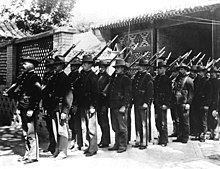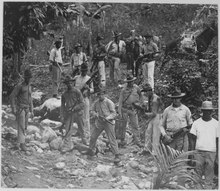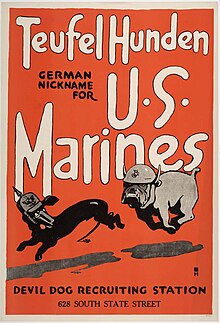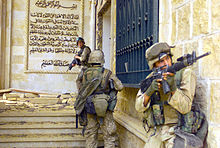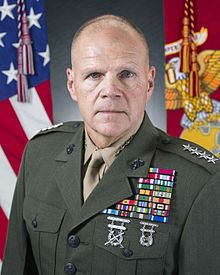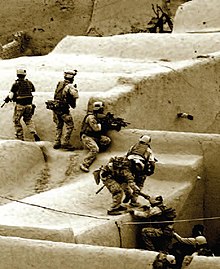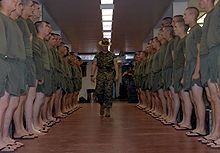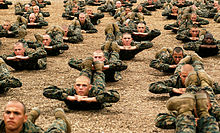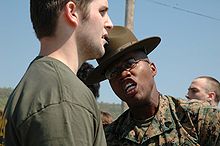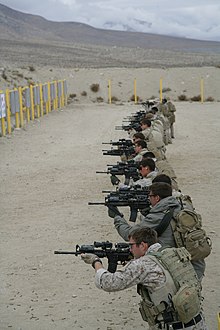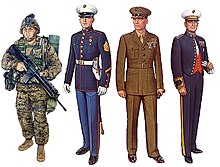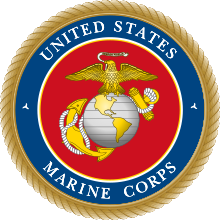United States Marine Corps
|
United States Marine Corps |
|
|---|---|

|
|
| Lineup | November 10, 1775 |
| Country |
|
| Armed forces | United States Armed Forces |
| Type | Armed forces ( marine infantry ) |
| Strength | 186,100 active members
38,500 reservists |
| Insinuation | United States Department of the Navy (since 1834) |
| headquarters | Marine Barracks Washington |
| motto | Semper Fidelis ( Latin for "always faithful") |
| march |
Semper Fidelis Official Anthem: The Marines' Anthem |
| Civil and military leadership | |
| Secretary of the Navy | Richard V. Spencer |
| Commandant of the Marine Corps | General Robert B. Neller |
| Assistant Commandant of the Marine Corps | General Glenn M. Walters |
| insignia | |
| Eagle, Globe and Anchor |

|
The United States Marine Corps ( USMC ; German Marine Corps of the United States ), often referred to as Marines or US Marines , is a branch of the United States' armed forces and one of the Uniformed Services of the United States , intended for rapid missions overseas and amphibious Warfare . In 2019 it had 186,100 active soldiers and 38,500 reservists.
In order to fulfill its tasks, the USMC has, in addition to marine infantry , the full range of weapons ( artillery , tanks , etc.) as well as its own air forces .
With sea-based operations, the USMC intervenes worldwide to protect US interests. Marines are on guard duty on US Navy ships . Furthermore, they are in sensitive state-owned institutions at home and abroad (for example, embassies of USA used) as a guard and control personnel.
history
Lineup
By resolution of the Continental Congress of November 10, 1775, two battalions of Continental Marines were set up shortly before the outbreak of the American Revolutionary War . The first recruits were recruited at the Tun Tavern in Philadelphia . The Continental Marines did not serve exclusively as landing forces for the recently created Continental Navy , but increasingly distinguished themselves through a large number of missions, for example through a surprise attack on the Bahamas in March 1776. In addition, they carried out isolated infantry operations from the land . The Continental Marines were dissolved together with the Continental Navy before the Paris Peace Treaty was concluded in April 1783, but were reorganized on July 11, 1798. Despite this period of nonexistence, the Marines celebrate the Corps' birthday annually on November 10th to create continuity.
American-Tripolitan War 1801–1805
The USMC has achieved worldwide fame in several wars , as can also be seen from the first line in the hymn of the Marine Corps: From the halls of Montezuma to the shores of Tripoli ("From the halls of Montezuma to the coasts of Tripoli") . In the early 19th century, First Lieutenant Presley O'Bannon led a group of seven Marines and several hundred mounted Egyptian Mamluk warriors during the American Tripolitan War in order to get rid of the ruler Jussef Karamanli in Tripoli . At the same time, a special command was supposed to destroy the US frigate Philadelphia , which had run aground off Tripoli and was now in the hands of Karamanli. O'Bannon's symbolic, but very central, contribution was instrumental in the USMC's elitist ethos . Impressed by O'Bannon's courage in battle, the head of the Muslim followers, Hamet Karamanli, gave him his Mamluk sword. Since 1825, every officer of the USMC has received such a parade sword with his officer's certificate.
British-American War
In 1814, an outnumbered association of marines and militia was dispersed by British forces at the Battle of Bladensburg , which subsequently took several days to burn down public buildings in the capital, Washington (including the White House).
Mexican-American War
The Marines took part in the Mexican War from 1846 to 1848, in which they landed on both the Atlantic and Pacific coast of Mexico. In addition, a battalion of the Marines stormed the Castillo de Chapultepec , which towers over Mexico City , after the Marines joined the forces of Army Officer Winfield Scott . Similar to the White House , they were assigned guard duty over the Mexican presidential palace , which the hymn of the Marines calls "Halls of Montezuma " (The Halls of Montezuma) .
Civil War
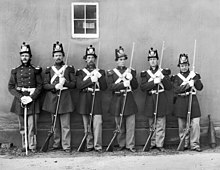
At the beginning of the American Civil War, fewer than 1,900 Marines were serving in the Marine Corps, including all ranks. On March 16, 1861, the Confederate States Congress founded the counterpart to the US Marines , the Confederate States Marine Corps . As a result, 16 officers and about 100 other soldiers deserted from the USMC and defected to the south. In the northern states, however, the defection of these militaries caused a strategic bloodletting, as some of the best Marines were among them. In addition, an open conflict broke out between the flag and staff officers of the USMC . The latter viewed themselves more as administrators and not as leaders of the war, while the Admiralty tried to regain its strength by patronage . As a result of these events, only 13 officers and 336 other marines, the majority of which were recruits, took part in the first battle at Bull Run , which meant that they could not perform as expected and fled the battlefield like the rest of the Union troops. In another mission, the landing at Fort Fisher , only the intervention of the land forces prevented a defeat of the Marines. The army's staff of almost 500,000 also marginalized the marines, so that their main task remained the guarding of bases.
The time up to the turn of the century: uprisings and "banana wars"
In the remaining decades of the 19th century, the Marine Corps' strength and importance within the military declined . As the US Navy shifted from sailing ships to steamers, the purpose of marines on warships has been challenged. Soon, however, the Marines became a useful tool in politics. They came (in so-called "small wars" Engl. : Small wars ) and to protect its own citizens and investments in foreign countries for use, such as Formosa (1867) and Korea (1871).
In the period between the end of the civil war and the end of the 19th century - the heyday of imperialism - there were 28 further missions for the Marines in countries such as China , Japan , Nicaragua , Uruguay , Mexico , Panama , Egypt , Haiti and Samoa , Argentina , Chile and Colombia . Furthermore, they were used in this era on the territory of the USA in political unrest and labor disputes .
During the Spanish-American War , the Marine Corps carried out landing operations in Cuba , Puerto Rico , Guam and the Philippines , and between 1899 and 1902 they participated in the crushing of the Philippine independence movement and the Boxer Rebellion in 1900.
In the period before and after the First World War , her international fame grew in the banana wars in Haiti, Mexico, Panama, Nicaragua and the Dominican Republic , where the corps was used against opponents of the occupation such as Augusto César Sandino or Charlemagne Péralte . To support the occupation, local troops were set up as de facto colonial police forces, such as the Guardia Nacional de Nicaragua or the Gendarmerie d'Haïti , who were also uniformed and trained by marines in the same way as the Marine Corps . Major Smedley D. Butler was, for example, major general of the gendarmerie while he was serving in Haiti . With these military interventions, the US enforced the Monroe Doctrine . The knowledge acquired in the wars of intervention in the field of guerrilla warfare and infiltration was written down in the groundbreaking Small Wars manual .
As the first military institution of the United States, the Corps received 1,915 armored vehicles of the type King (King Armored Car). From them the 1st Armored Car Squadron of the Corps was formed, which was deployed shortly afterwards in Haiti.
First World War
During the First World War, the Marines, which at the time basically had far more operational experience than the US Army , were an important pillar of the American war effort. In contrast to the Army, when the USA entered the war, the marines were able to fall back on a large number of officers and NCOs. For this reason, the proportion of inexperienced or untrained soldiers was relatively low. As part of the American Expeditionary Forces (AEF), the Marines adopted as part of the 2nd Infantry Division of the Army in July 1918, the Battle of Belleau Wood in part, its previously significant combat. There they were distinguished by their particular toughness. This earned them the nickname "First to fight!" According to American war reports, the German soldiers are said to have called the marines "devil dogs" after the German forces were finally pushed back from the area; The US Marines proudly retained the translation of Devil Dogs . Since the designation cannot be traced in any German source and is also contradictory handed down (in correct German it would be called “devil dogs”), the question of who actually came up with it must remain open.
Second World War

In the Second World War , the USMC played a major role in the Pacific War , which made it necessary to increase its number from two brigades to two corps with a total of six divisions and the naval aviation to five air forces with 132 squadrons .
In 1942/45 the fighting over Wake Island , Guadalcanal , Tarawa , Peleliu , Iwo Jima and Okinawa resulted in heavy losses. The Navajo Code , developed to maintain radio secrecy within the Marine Corps , helped ensure that these were nevertheless successful.
During the battle of the island of Iwo Jima, the famous picture of five Marines and a Navy medic hoisting the US flag on the Suribachi was taken . The photographer Joe Rosenthal defended himself all his life against the accusation that he had staged this. The war correspondent had missed the setting up of the first, smaller flag. His Pulitzer Prize- winning photo shows the moment a few hours later when the soldiers hoisted a larger stars and stripes. Actions like this, some of which were planned or the execution of which was reserved for the Marines, added to the positive reputation of the already popular Marines among their own population.
In honorable memory of all the fallen Marines and a special tribute to the fighters on Iwo Jima provided was since the establishment of the USMC in 1775, financed from donations on November 10, 1954 the 179th anniversary of the United States Marine Corps War Memorial in Arlington , based on the presentation of the world-famous photo of Rosenthal, inaugurated by the then US President Dwight D. Eisenhower .
Korean War
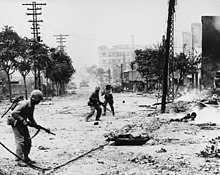
During the Korean War (1950 to 1953), the Marines landed at Incheon and, in joint association with the US Army, advanced to North Korea , where they reached the Yalu River . Here the People's Republic of China , fearing for its influence, began to send a large number of troops over the Yalu, which were supposed to hold the US-American units in Korea, and even pushed them back.
In the battle for the Chosin Reservoir , the experienced 1st Marine Division fought the numerically superior but poorly equipped and poorly trained Chinese troops . During this extremely bloody battle, the Marines picked up the material left behind by the US Army, which had already started the orderly retreat , collected themselves, and stormed the Chinese positions in order to be able to retreat to the coast themselves.
Vietnam War
In the Vietnam War , too , marines fought in many of the great battles, such as Da Nang , Hue or Khe Sanh . They were among the first troops officially deployed in Vietnam in 1965 . In 1971 the Marines were withdrawn from Vietnam as part of the troop withdrawal decided by President Richard Nixon . Four years later, in the last days of the war in Vietnam, there was a brief aftermath when it came to evacuating members of the US embassy in Saigon before the advancing Viet Cong troops . During this period, the Marines were also involved in the Mayaguez Incident , the last armed conflict between United States forces and the Khmer Rouge.
During the Vietnam War, a newly established special unit called Force Reconnaissance was deployed for the first time . Its mission profile is primarily geared towards reconnaissance .
From the Vietnam War to the end of the Cold War
The Marine Corps was involved in all US military actions after 1975, such as the 1983 invasion of Grenada or the 1989 invasion of Panama . It suffered its worst casualties since the Vietnam War when the US base in Beirut was attacked in 1983 , when over 200 Marines died.
After the cold war
The Marines were responsible for the liberation of Kuwait in 1991 . The US Army invaded Iraq without encountering any resistance.
1,995 Marines rescued Captain Scott O'Grady , one over Bosnia downed fighter - pilots of the US Air Force , in a so-called TRAP mission (Tactical Recovery of Aircraft and Personnel) .
Since 2003, Marines have also been serving as part of what is known as the Coalition of the Willing . They were also involved in the previous invasion of Iraq . In 2005, marine soldiers killed 24 Iraqi civilians, including children, in revenge for the death of a comrade. This war crime came to be known as the " Haditha Massacre ".
In February 2004, the 1st Marine Division was relocated back to Iraq to secure Al Anbar Province west of Baghdad. There she participated as a core unit of the US troops in Operation Vigilant Resolve , as well as in Operation Phantom Fury . In February and March 2005 she was replaced by the 2nd Marine Division. This was the largest Marine Corps relief and detachment operation in its history.
In 2006, Marines evacuated US citizens from Lebanon during the Lebanon War .
In 2011 it was planned to station 2500 Marines in Darwin , Australia . This corresponds to a reinforced Combined Arms Marine Air-Ground Task Force (MAGTF). The first 200 soldiers were deployed in April 2012, and the number is to be increased to 2500 by 2017. The Marines are not permanently stationed, but only stay in Darwin for six months a year.
Racial politics
In the American Revolutionary War, people of different skin colors fought against each other on both sides. Between 1776 and 1777, about a dozen black Marines fought for the American side. War Secretary James McHenry later banned the admission of blacks, mulattos and Indians, so that between 1798 and 1942 blacks were excluded from the corps or were denied access. Mostly whites served as Marines apart from a few white Latinos and Americans of Asian descent. When the admission of blacks to the Corps was discussed in 1941, the then commandant of the Marines, Major General Thomas Holcomb , vehemently opposed it. He would prefer 5,000 whites to 250,000 negroes . In 1942 blacks were allowed to join the Marine Corps, albeit in separate units, while other non-whites served with whites. It was not until 1960 that racial segregation was completely repealed. In 1942, Navajo Indians were also accepted into the corps, who were used as radio operators in the Pacific War (see also Navajo Code ). These also served in separate units. Until 1944, Americans of Japanese origin were banned from serving in the US Army. As of 1944, none of them were allowed to serve in the USMC. In 2014, approximately 10% of the USMC are African American and 16% are Hispanic.
Mission and Doctrine
assignment
The existence of the United States Marine Corps is legitimized by the Constitution of the United States , more precisely in Article II, Section 2, Paragraph I, Clause 1 and Article I, Section 8, Clause 11 and 14. This assigns the budget authority to Congress and thus also the financing of the military, while the organization of the armed forces is under the authority of the President.
The United States Marine Corps is entrusted with a three-part mandate that establishes Book 10 of the United States Code , Federal Defense Law, since the National Security Act of 1947. Section 5063 sets out this in paragraph (a) :
"[...] The Marine Corps should be organized, equipped and trained in such a way that it can provide the Fleet Marine Forces in combined arms combat , together with assisting air components, for service in conjunction with the Fleet [in the sense of naval units ] are decisive for the conquest or defense of upstream naval bases and for ground warfare. "
This means, above all, the conquest or defense of maritime outposts in the context of naval warfare in association with the United States Navy, as well as the development of tactics and the procurement of equipment that are necessary to carry out amphibious landing operations. Furthermore, "[...] the Marine Corps should provide departments and structures for [guard] duty on armed naval vessels as well as security departments for the protection of naval property at naval bases". Members of the USMC therefore guard United States diplomatic missions , the US Navy's main nuclear weapons facilities and those on aircraft carriers, and stand guard outside the White House . The special character of the armed forces is emphasized by the provision that the marines must also carry out operations of a similar nature as ordered by the president. However, the legal provision regards these “additional” tasks as subordinate, as they are not intended to “distract” or “interfere” with the first-mentioned mission, for which the US Marine Corps is “primarily organized”. Also required is a nominal minimum size of three divisions intended for combat operations and three air wings , and all units that need them to fulfill the mission.
A limitation in paragraph (b) regulates the relationship to the other branches of the armed forces, as the operational profile would otherwise overlap with those of the Army and the Air Force . Literally it is said that the Marines "in cooperation with the Army and the Air Force [should] work out those periods of an amphibious landing operation, which concern the tactics, procedures and equipment of a land force". This is a differentiation to the much broader orders of the former.
Principle doctrine
In 1989, the then Commandant of the Marine Corps , Alfred M. Gray , published the Marine Corps Doctrine Publication 1 , entitled Warfighting , in which he elaborated the basic doctrine of the armed forces called Maneuver Warfare . He defined this concept as follows:
" Maneuver Warfare is a philosophy of warfare that seeks to shatter the enemy's cohesion through a variety of fast-paced, bundled, and surprising processes in order to trigger [for him] an increasingly deteriorating situation that he can no longer control."
He wanted this concept to be understood in contrast to the operational concepts that were still valid during the Cold War , in which the enemy was primarily to be worn down with overwhelming firepower . Firepower was also of great importance to Gray, but he requested that it be aimed at the enemy's weak points in order to overwhelm the enemy, leaving open the physical annihilation of the enemy. In addition, Warfighting implemented Commander’s intent , i.e. command and control, and arranged priorities for each strategy .
At the tactical level, the Marine Corps applies the principle "Every Marine a Rifleman (first)" , meaning: "Every Marine is (first and foremost) an infantry soldier ". This slogan comes from the Korean War and has practical, idealistic and historical backgrounds. When they were established, the Marines required each recruit to use their own musket as a service weapon . This tradition developed to such an extent that the Marines in the Korean War were the only part of the armed forces that could form entire combat companies entirely from non-infantrymen. Today's significance is mainly due to the fact that all crew ranks are fully trained infantrymen regardless of their later specialization . The value of this principle has been shown several times during the history of the Marines: For example, in the Battle of Wake Island in World War II, after all the Marines' fighter jets were shot down, their pilots were able to lead auxiliary troops on the ground into further defensive efforts. In the same way, all officers receive training as infantry platoon leaders . In addition, the saying expresses the equality of all Marines and their camaraderie.
organization
Politico-military leadership
As for all US armed forces and their entirety, the commander in chief is the President of the United States , who leaves the day-to-day management, supervision and administration to the Secretary of Defense . The mission and history of the US Marine Corps are closely intertwined with those of the Navy , which is why both branches of the armed forces are subordinate to a joint department in the Department of Defense , the Department of the Navy , which is led by the Secretary of the Navy (SECNAV) . Because of this interdependence, for example, the marines do not have their own paramedics ( hospital corpsmen ) and military chaplains . These tasks are performed by members of the Navy for them.
The USMC's senior officer is the Commandant of the Marine Corps (CMC), who is a permanent member of the Joint Chiefs of Staff . He is responsible for organizing, recruiting, training and equipping the Corps so that the Marines are ready for service under the command of the Unified Combatant Commander . He is supported by the Assistant Commandant of the Marine Corps (ACMC) as deputy and the Sergeant Major of the Marine Corps (SMMC) as the highest non-commissioned officer . Current incumbents are: General Robert B. Neller (CMC), General Glenn M. Walters (ACMC), and Sergeant Major Ronald L. Green (SMMC).
Operational structure
The USMC is divided into four basic areas: the Marine Corps Headquarters (HQMC), the operations forces , the combat support forces, and the Marine Forces Reserve . The operational forces in turn are divided into four categories: the Marine Corps Forces (MARFOR), which are assigned to the individual Unified Combatant Commands , the Marine Corps Security Forces , which guard the facilities of the Corps and the US Navy , and the Marine Corps Security Guard , assigned to the individual US embassies abroad.
The Marine Corps Forces are in turn divided into Marine Forces Command (MARFORCOM) and Marine Corps Forces Pacific (MARFORPAC), each under the command of a Lieutenant General . The MARFORCOM in Norfolk , Virginia , is subordinate to the II. Marine Expeditionary Force and the MARFORPAC in Camp HM Smith in Hawaii, the I. and III. Marine Expeditionary Force .
The commander of MARFORCOM in Norfolk also has other combined powers of command. He is also commanding general of the Fleet Marine Force Atlantic (FMFLANT) and commander of the US Marine Corps Bases Atlantic .
Combat support forces also include the Marine Corps Combat Development Command (MCCDC), Marine Corps Recruit Depots San Diego and Parris Island , Marine Corps Logistics Command, Marine Corps Bases (MCB), and Marine Corps Air Stations (MCAS) , the Recruiting Command and the United States Marine Band (“The President's Own”) and United States Marine Drum and Bugle Corps “The Commandant's Own”.
Currently (2008) the Marine Corps ground combat forces consist of four divisions :
- the 1st Marine Division at Camp Pendleton , California ;
- the 2nd Marine Division at Camp Lejeune , North Carolina ;
- the 3rd Marine Division at Camp Smedley Butler in Okinawa , Japan ; and
- the 4th Marine Division is a reserve organization with headquarters in New Orleans , Louisiana
In World War II, two more Marine infantry divisions were set up: the 5th Marine Division and the 6th Marine Division . Both were used against the Japanese in the Pacific theater and were disbanded after the war. The 5th was temporarily re-established during the Vietnam War and operated from March 1, 1966 to November 26, 1969.
The USMC's airmobile units consist of four Marine Aircraft Wings (equivalent divisions):
- the 1st Marine Aircraft Wing in Okinawa , Japan ;
- the 2nd Marine Aircraft Wing at Marine Corps Air Station Cherry Point , North Carolina ;
- the 3rd Marine Aircraft Wing at Marine Corps Air Station Miramar , California ; and
- the 4th Marine Aircraft Wing , a reserve association.
The USMC's logistics groups comprise four Marine Logistics Groups (equivalent divisions):
- the US 1st Marine Logistics Group at Camp Pendleton, California;
- the US 2nd Marine Logistics Group in Camp Lejeune, North Carolina;
- the US 3rd Marine Logistics Group in Okinawa, Japan;
- the US 4th Marine Logistics Group in New Orleans, Louisiana.
Marine Corps Forces Special Operations Command
The USMC has long been reluctant to assign Marines to the US Special Operations Command (SOCOM) on a permanent basis for special operations because it was of the opinion that there could be no parts of a force that sees itself as an elite in its entirety that are permanently attached to it more elitist tasks. This position was abandoned in 2003 under pressure from the National Command Authority and the Marine Corps Forces Special Operations Command (MARSOC) was founded and subordinated to SOCOM. It is the component command of the Marines within the Special Operations Command. The MARFOR personnel were recruited from a considerable number of former soldiers of the Marine Corps Force Reconnaissance, which was regrouped in 2006 .
Marine Air Ground Task Force Concept
The units of the USMC can, depending on the order situation, be grouped into a task force in different sizes. The concept of the Marine Air-Ground Task Force (MAGTF) is always the basis.
Mission groups according to the MAGTF concept basically contain four basic components: Staff component ( Command Element ), ground combat component ( Ground Combat Element ), air combat component ( Aviation Combat Element ) and a supply component ( Logistics Combat Element , formerly Combat Service Support Element ).
The staff component represents the headquarters and commands the other components. The ground combat component is provided by infantry units reinforced with armored units and artillery. It also includes special forces such as long-distance scouts (Force Reconnaissance), snipers and upstream air command units. The aerial combat component is intended to ensure the total air superiority of the MAGTF. It includes combat aircraft as well as helicopters, their pilots and their repair units. All combat support units are housed in the supply component. It includes specialists such as telecommunications, maintenance engineers, transport and logistics units, as well as medical supply units.
The USMC uses the MAGTF concept in three orders of magnitude adapted to the order.
MEU

The smallest of these associations is the Marine Expeditionary Unit (MEU) . MEU are the smallest independently operating associations, trained to operate independently or in a larger association. Each MEU is able to take on special operations (Special Operations Capable - SOC) .
The staff component forms the headquarters and is usually commanded by a colonel . The ground combat component is a Battalion Landing Team (BLT) , consisting of an infantry battalion, which is usually reinforced by an artillery battery, and a platoon of engineers, tanks, amphibious tractors and armored vehicles. The air combat component is a transport helicopter squadron, reinforced by combat aircraft (AV-8B or F-35C) and helicopters. The supply component consists of a Combat Logistics Battalion that takes on all logistical and administrative tasks of the association. The exact composition of an MEU can be adapted to the order, so it is possible to include more artillery, armored units or more air support.
In general, three MEUs are assigned to the US Navy's Atlantic and Pacific fleets , and one more is stationed in Okinawa. While one MEU is deployed on duty, the second is used for training and further education and the third grants the soldiers a break.
MEB
The next largest unit is the Marine Expeditionary Brigade (MEB) . Instead of a BLT, a reinforced regiment ( Regimental Combat Team ) forms the basis and is equipped with larger air combat contingents (usually a squadron known as a Marine Aircraft Group ) and a higher supply capacity ( Combat Logistics Regiment ).
MEF
The largest associations according to the MAGTF concept are the Marine Expeditionary Forces (MEF) . In peacetime they consist of a Division, a Marine Air Wing and a Combat Logistics Group .
The three Marine Expeditionary Forces make up the Fleet Marine Force , a rapid reaction force that can be deployed worldwide and that operates from the five operational fleets of the US Navy. The first and third MEF will be used in the Pacific region and the second MEF in the Atlantic region.
I. Marine Expeditionary Force , Headquarters
- 1st Marine Division (Camp Pendleton, California)
- 3rd Marine Aircraft Wing (Camp Pendleton, California)
- 1st Marine Logistics Group (Camp Pendleton, California)
- 1st Marine Expeditionary Brigade
- 11th Marine Expeditionary Unit
- 13th Marine Expeditionary Unit
- 15th Marine Expeditionary Unit
- Air Contingency MAGTF (ACM)
II. Marine Expeditionary Force , special operations training group
- 2nd Marine Division
- 2nd Marine Aircraft Wing
- 2nd Marine Logistics Group
- Chemical Biological Incident Response Force (CBIRF)
- II MEF Augmentation Command Element (II MACE)
- 2nd Marine Expeditionary Brigade
- 22nd Marine Expeditionary Unit
- 24th Marine Expeditionary Unit
- 26th Marine Expeditionary Unit
III. Marine Expeditionary Force
- 3rd Marine Division
- 1st Marine Aircraft Wing
- 3rd Marine Logistics Group
- 31st Marine Expeditionary Unit (Okinawa, Japan)
- Air Contingency MAGTF (ACM)
Basic structure of associations and units
The basic structure of the ground combat units of the USMC is based on the "rule of three". This rule states that there are always three subordinates and one commander. This rule of course also has exceptions, as required by the operational situation, there can also be four subordinate units or the commander has a lower or higher rank than the one required.
- A fire team ( German troop ) is the basic element and consists of four marines, three riflemen and a troop leader (team leader) , usually a corporal - 1/3.
- A squad (dt. Group ) consists of three fire teams and will be of a Staff Sergeant as a group leader (leader squad) out - 4/9.
- A rifle platoon (dt. Schützenzug ) consists of three squads, a Navy Corpsman , a platoon Sergeant and a platoon commander. It is usually run by a second or first lieutenant - 1/13/28 = 42.
- A rifle company (dt. Schützenkompanie ) consists of three rifle platoons , a weapons platoon (46 marines with SMAW , mortars M224 and machine guns M240 ), and the company lead group , total 175 marines. Company commander is usually a captain .
- An infantry battalion consists of three rifle companies as well as a staff and heavy weapons company and is commanded by a Lieutenant Colonel . In the infantry, there are also weapon companies (heavy arms companies with mortars, heavy machine guns and anti-tank weapons transported on Humvees) as well as staff and support companies, which are made up of a staff, a telecommunications and a supply platoon and a battalion troop formation area.
- A regiment consists of three battalions and is led by a colonel . In literature and in informal everyday service, the regiment is omitted from the name , so that, for example, 8th Marines means the 8th US Marine Regiment.
- A division consists of three infantry regiments and is commanded by a major general . In addition, the divisions are usually subordinate to an artillery regiment and a battalion each of reconnaissance aircraft, tanks, engineers, amphibious tractors and armored reconnaissance aircraft. Some battalions, which according to this system should actually be located in the 3rd Marine Division, are currently subordinate to the 1st and 2nd Marine Divisions.
A brigade is commanded by a Brigadier General , is generally only used in the USMC in the form of the Marine Expeditionary Brigades described above and consists of one or more regiments.
The headquarters of battalions and larger units have an S-3 Executive Officer (XO) for operations planning and other officers for personnel management (S-1), military intelligence (S-2), logistics (S-4), and civilian military cooperation (S-5) and for telecommunications (S-6).
The air combat units are divided into so-called Marine Air Wings (division equivalent), each of which leads several Marine Aircraft Groups (regimental equivalent). The Aircraft groups each headed by one to nine flying squadrons ( Squadrons ). The latter are led by a Lieutenant Colonel and consist of six to 15 aircraft of the same type, divided into seven to eight sections .
The names of the logistics associations are usually subject to a similar terminology as the infantry, but the division equivalent are so-called Combat Logistics Groups .
bases
Ranks
- Ranks of non-commissioned officers
| Non-commissioned officers (German equivalent: “ NCOs without and with portepee ”) of the United States Marine Corps | |||||||||
|---|---|---|---|---|---|---|---|---|---|
| US pay level | E-9 | E-8 | E-7 | E-6 | E-5 | E-4 | |||
| Sleeve badge |

|

|

|

|

|

|

|

|

|
| Rank | Sergeant Major of the Marine Corps | Sergeant Major | Master Gunnery Sergeant | First sergeant | Master Sergeant | Gunnery Sergeant | Staff sergeant | sergeant | Corporal |
| abbreviation | SgtMajMC | SgtMaj | MGySgt | 1stSgt | MSgt | GySgt | SSgt | Sgt | Cpl |
| NATO rank code | OR-9 | OR-9 | OR-9 | OR-8 | OR-8 | OR-7 | OR-6 | OR-5 | OR-4 |
Recruitment and training

The basic training of the United States Marine Corps (offz. English : United States Marine Corps Boot Camp ) is by far the most demanding of all branches of the United States of America . It takes place centrally, but the recruits are brought to one of two training centers depending on their gender and geographic origin. Men who lived west of the Mississippi at their engagement are trained at the Marine Corps Recruit Depot San Diego . Men who come from areas east of the Mississippi and all female recruits come to the well-known Marine Corps Recruit Depot Parris Island for their basic training . The training takes place separately by gender.
The Marines' Boot Camp is known around the world due to a wide variety of media coverage . The comparatively rigorous drill is part of the outstanding reputation that the United States Marine Corps enjoys among the armed forces. The methods used in training arouse both admiration and offense worldwide. The most famous cinematic representation of the boot camp succeeded Stanley Kubrick for his film Full Metal Jacket in 1986, in which the former Marine R. Lee Ermey represented the instructor. However, there are innumerable other representations, especially in US popular culture .
Except for the geographical and climatic conditions, the conditions for both training locations are the same. Due to their proximity to the film production site and the better average weather, recruits from Parris Island mock their comrades in San Diego as Hollywood Marines , while they counter with the expression hump-waivers (approximate translation: "slope-free") with a view of the flat terrain of the island .
Since the Women's Armed Service Integration Act went into effect on June 12, 1948, women have served in the Marine Corps in regular units. In 2004, 6.2 percent of all Marines were women; in absolute numbers in February 2008 over 1,100 officers and over 10,000 soldiers were women. Women now serve in the Marine Corps in 93% of all careers.
In January 2014, the Marines suspended the pull-up tests for female soldiers because "a little more than half of the participants in a training session did not manage to do three pull-ups, but the army did not want to create any insurmountable hurdles for women."
procedure
Basic training in the United States Marine Corps lasts 13 weeks and is divided into three phases. In the first phase military basics are taught, while in the second the focus is on shooting. In the third and final phase, the skills learned are increasingly implemented in realistic exercises. The individual phases are counted in days (Training Day, TD) and not in weeks. In some details, however, the recruit training in San Diego differs from that in Parris Island in terms of its process.
- Phase I.
The first phase of basic training lasts 24 days. In the first three days, the recruits are made familiar with the basic drill of the training and practice military ceremonies . In addition, they are instructed in the language of the Marine Corps , which indicates the origin of the armed forces from shipping. In the following four days, the physical resilience of the recruits is examined (initial strength test) , with a two-day exercise for the men following the previous exercise for the women. When the applicants were originally recruited, they were only examined for medical and psychological suitability , but not for their actual fitness. Recruits who do not meet the requirements of the IST are downgraded to the Physical Conditioning Platoon ( PSP , " Train for physical adjustment"), where only their fitness is trained.
Other significant contents of the first phase are martial arts as part of the Marine Corps Martial Arts Program , fights with pugil sticks , padded wooden poles, and first aid .
- Phase II
The second phase of the basic training lasts 23 days and, in addition to practicing tactical situations, is primarily dedicated to training in the art of shooting ( marksmanship ) . This includes handling the weapon in general, including safety rules and their cleaning. When shooting, different postures are used to fire at different targets at different distances. In general, the recruits achieve a high level of accuracy. Behind this is a conviction that is manifested in the motto Every Marine a rifleman (“ Every Marine a Rifleman ”). Furthermore, the central values of the Marine Corps are conveyed (core values) .
- Phase III
The evaluation process begins in the third phase. The recruits receive extensive military training. The culmination of the entire training is a final exam called The Crucible . The recruits are exposed to numerous physical and mental stresses. In 54 hours they go through several realistically simulated situations, while they are allowed four hours of sleep per night and a maximum of three field rations ( meal, ready-to-eat , MRE) .
equipment
The Marine Corps largely uses the same weapons and equipment as the Army , but unlike the Army it still uses the M16 in the A2 and A4 versions as the standard weapon . The M4 is also used in addition . The Marine Corps also has in-house developments such as the landing craft AAV7 A1 and the USMC Designated Marksman Rifle , a modified M14 , the latter of which has since been withdrawn.
vehicles

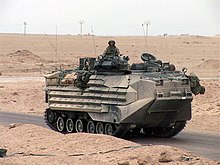

- M1 Abrams main battle tank
- LAV-25 , armored vehicles in different versions (25-mm-MK, AT- TOW , AD- Luftabwehr with eight FIM-92 Stinger and 25-mm-cannon, C2-Kommando, recovery vehicle)
- AAV7 Amtrac , amphibious landing vehicle
-
HMMWV (Humvee)
- MRAP , protected vehicle, successor to the HMMWV
- from 2018 the Humvee will be replaced in 5,500 copies by the Oshkosh JLTV
- IFAV, Mercedes-Benz MB 290 GD, Wolf (IFAV: Interim Fast Attack Vehicles)
- Internally Transportable Vehicle ITV , off-road vehicle that can be transported by air, replacing the IFAV
- Logistics Vehicle System , a similar version of the US Army Heavy Expanded Mobility Tactical Truck (HEMTT) 10 ton truck
- Medium Tactical Vehicle Replacement an armored 7-ton truck
- Terex Demag MAC 50 , 50 tonne mobile crane
- HIMARS High Mobility Artillery Rocket System, mobile rocket launch unit
- M88 Recovery Vehicle , armored recovery vehicle
- various support vehicles, including various military bulldozers from Caterpillar
artillery
Aircraft
- CH-46 Sea Knight
- CH-53 Super Stallion
- AH-1W Super Cobra / AH-1Z Viper
- UH-1N + Y Huey
- VH-60 Black Hawk , under the identification Marine One only for the presidential transport in VIP version
- AAI RQ-7 , a drone ( UAV )
- Boeing ScanEagle , also a drone
- EA-6B Prowler
- AV-8B Harrier II
- F / A-18 AD Hornet
- KC-130 Hercules , for troop and material transport and for air refueling
- UC-35C Ultra , UC-35D Encore
- MV-22 Osprey (tilt rotor aircraft)
Future weapon systems
The Marine Corps version of the F-35 marks the end of a nearly fifty-year search for an all-purpose VTOL, which, for lack of alternatives , had procured the British Harrier Jump Jet in the 1960s . The cost difference compared to the Air Force version is approximately 20 million US dollars each. In total, the USMC has budgeted nearly $ 50.5 billion for the entire program. Due to a recommendation of the National Commission on Fiscal Responsibility and Reform from November 2010, this variant was in a probation phase and in the meantime it was threatened with complete deletion. In January 2012, Defense Minister Leon Panetta announced the end of the probationary phase through the progress made in the program.
Uniforms
The uniforms of the USMC are often confused with those of the United States Army , although the following specifics exist:
- Marines do not wear berets .
- Marines only wear their combat boots with their combat suits .
- Because of their naval affiliation, they only salute when they are wearing headgear .
Since late 2002, the USMC has been using a new combat suit that has been introduced gradually. This one has a new type of camouflage pattern called MARPAT (shortening of marine pattern ). This digital camouflage print is intended to camouflage the Marines in the field even better by diverting the focus of the eyes. Together with the uniform - exclusively for the marines - new combat boots were delivered to the troops. The new boots are light brown and have been developed especially for hot climates. The Marines' MARPAT camouflage pattern is available in two versions, one for use in the desert and the other designed for forested areas. The US Army has also been using a digital camouflage pattern since 2005 , which was introduced as the Universal Camouflage Pattern with the Army Combat Uniform , but there was a color difference and a different cut. However, the digital sample was taken out of service after a short time because it had proven to be completely inadequate in use. As early as 2010, under pressure from the US Congress, the camouflage scheme was re-tendered. The Operational Camouflage Pattern introduced in mid-2015 emerged as the winner from this competition .
Ethos
Marines call themselves jarheads (this illustrates the view that a marine's head is like an empty jam jar that is filled during training and then sealed), leathernecks (leather necks) or devil dogs (devil dogs ). Its outstanding role as an expeditionary and intervention force gave rise to the image of an elite association .
Internally, members of the USMC who have left the service are unofficially referred to as Former Marine (the term “Retired Marine” is officially in use), never ex-Marine . It means that although the person is no longer in active service, he is still part of the community.
emblem
The emblem of the Marines bears the fixed name Eagle, Globe, and Anchor and took shape in 1868 for the first time. A predecessor of today's emblem was proposed by a commission on November 13, 1868 and accepted six days later by the then Minister of the Navy, Adolph E. Borie . The commission was probably based on the emblem of the British Royal Marines called Globe and Laurel (" Globe and Laurel Branch"). Marines had previously decorated themselves with changing ribbons, ornaments and jewelry.
In the eagle, globe & anchor symbol, a sea eagle with open wings clings to a globe, the viewer is facing the western hemisphere . The motto of the Marines, Semper fidelis (Eng .: Always loyal) is fixed in the eagle's beak . In the background there is an "unclear stick anchor " (foul anchor) . It is considered “unclear” (in the sense of “not operational”) because its chain is wrapped twice around it.
flag
Little is known about the flags of the United States Marine Corps prior to the 1830s. It can be assumed that at the beginning Marines mostly carried the Continental Flag with them.
By the late 1840s, the flag of the Marine Corps had a white background and a gold border. It showed an eagle and an anchor. In memory of the Barbarian Wars, the phrase To the Shores of Tripoli graced . After the victory over Mexico this was completed for today's introduction to the anthem (From the Halls of Montezuma to the Shores of Tripoli) .
In the war against Mexico and the Southern States, the Marines then used a banner with white and red stripes, which included the Union's war flag. In the center, an eagle towered over the seal of the United States . From 1876, the United States Marine Corps carried a stars and stripes with yellow self-designation in the middle red stripe. From 1914 onwards, the Corps gave itself a new flag, which in principle corresponds to today's flag, with the difference being a blue background. Production of the 1876 banner ceased in 1921, and from 1940 the United States Flag Act prohibited deviations from the official appearance, such as lettering or a gold border.
The current design of the flag of the Marine Corps was issued from 1939. The colors of the armed forces, yellow and scarlet , were officially adopted as early as 1935.
"Creed"
After the attack on Pearl Harbor wrote Major General William H. Rupertus in 1941 following text he simply My Rifle - A Warrior's Creed - (dt .: "My gun creed called a warrior"). It is also known as The Rifleman's Creed , My Rifle, and The Creed of The United States Marine . Since then, this text has been taught to every aspiring Marine.
In the course of time different versions of this poem appeared, in which the current events, in the sense of war opponents, were processed.
|
|
This poem was used in the films Full Metal Jacket ( Vietnam War ) and Jarhead ( Second Gulf War ). For reasons of dramaturgy , Stanley Kubrick's Full Metal Jacket has no middle section.
anthem
|
|
The Marines' Hymn is the USMC's official anthem . It is the oldest official anthem of all American armed forces . The melody comes from the opera Genevieve de Brabant by Jacques Offenbach , which premiered in Paris in 1859 . The text is from the 19th century; the author is unknown. On August 19, 1919, the Marine Corps secured the copyright , which has now expired.
For example, in JAG - On behalf of honor , episode 10 shows how the first and last stanza (duration about 1 minute) of a train of female recruits including their two drill instructors as part of the 3-month basic training on the occasion of the training in the " gas chamber "is sung in tears before then , finally, the gas masks against the exuded CS gas can be placed ...
motto
Since its inception, the motto of the Marines was Fortitudine (German: "With bravery") until it was replaced by By sea, by land in the British-American War of 1812 , a translation of the motto of the Royal Marines , Per mare, per terram ( German for example: "Over sea and land"). This changed to From the Halls of Montezuma to the Shores of Tripoli in 1848 , which later became the beginning of the USMC anthem.
Since about 1883 the motto of the United States Marine Corps has been Semper fidelis (German: “Always treu”), which in colloquial usage mostly means Semper fi! is shortened. The Marine Corps shares this motto with the Devonshire Regiment of the British Army and the grenadiers of the Swiss Army .
A USMC military march, also called Semper Fidelis , is often confused with the USMC hymn . Also not to be confused with the motto of the Corps is its long-standing advertising slogan Marines - The Few. The Proud. ("Marines - The Few. The Proud.")
Well-known marines
Military
- Major General Smedley D. Butler , who had served in numerous banana wars and who, in his work War Is a Racket, strongly opposed an interventionist US policy.
- Lieutenant General Lewis Burwell “Chesty” Puller , the most decorated officer in the history of the US Marine Corps.
- General Peter Pace served as the first chairman of the United Joint Chiefs of Staff from among the Marines from 2005 to 2007 .
- General James L. Jones was Commander of the US European Command and Supreme Allied Commander Europe (January 2003 to December 2006).
- General James T. Conway was the 34th Commandant of the Marines (November 13, 2006 to October 22, 2010).
- Corporal Ira Hayes fought in World War II, among other things, in the Battle of Iwojima . Because of his participation there in the photo of the hoisting of the US flag , he became known as a model Indian in the media.
- Gunnery Sergeant Carlos Hathcock had 93 confirmed kills as a sniper and, according to his own statements, more than 200 unconfirmed kills. He is still considered one of the role models for US snipers today.
- Lieutenant Colonel l Oliver North , in the Iran-Contra affair of the Reagan administration was involved.
Artists
- Private First Class Lee Marvin served with the Marines during World War II and was seriously wounded in the Pacific War ; As an actor, he was able to draw on his military experience in several war films. In 1985 he worked as a presenter in a documentary about the Marines.
- The writer Leon Uris processed his experiences in the Pacific War in his first novel Battle Cry (Eng. Battle cry).
- Other well-known actors who have served in the United States Marine Corps include George Peppard , Rock Hudson , Gene Hackman , Steve McQueen, and Harvey Keitel .
- One of the most famous siblings in pop history, the Everly Brothers , joined the Marines after their musical career.
- Another singing Marine with the rank of Lance Corporal is Shaggy ("Boombastic").
- R. Lee Ermey last served in the Vietnam War as a staff sergeant and became known after retiring from the service through the film Full Metal Jacket , in which he played Gunnery Sergeant Hartman . He was the first Marine to be promoted to retirement, to gunnery sergeant .
- The singer Al Martino .
offender
- Charles Whitman , who shot and injured numerous people in a rampage at the University of Austin in 1966
- Lee Harvey Oswald , the alleged murderer of American President John F. Kennedy
Engineers
- Eugene Stoner was a weapons designer who was instrumental in the development of the M16 assault rifle .
Quotes
The mission and history of the Marine Corps have popularized two winged words in United States culture . In first to fight! / First in the fight! This reflects the predominantly amphibious mission of the US Marine Corps. This adage is used on recruiting posters from the early 20th century and served as the title of two films from 1931 and 1967 (starring Gene Hackman), a book, and the computer game Close Combat: First to Fight .
In addition, every President of the United States is said to say the phrase Send in the Marines! ("Send the marines!") To have used. It is known to "every school boy" and popular in scientific journalism and as a media headline, even in a modified form. Arthur Herman called with Send the Marines! At the end of November 2008 in the New York Sun, the American politicians asked to stop the piracy in the Gulf of Aden with an invasion of Somalia. In August 2003, Kenneth Cain asked the United States in the New York Times to use a MAGTF in Liberia in the civil war there . In September 2001, Harold Pinter illustrated the threat by the United States to forcibly rescue every American soldier charged before the International Criminal Court from The Hague. The Marine Corps issued a strategy document in 2007 called The Long War - Send the Marines .
Details and special features
- The HMX-1 in Quantico , Virginia is typically responsible for transporting the President of the United States by helicopter. Once the President is aboard a United States Marine Corps helicopter, that aircraft is given the paging name Marine One .
- Law enforcement for the Marine Corps is carried out by the Naval Criminal Investigative Service (NCIS) of the US Navy in addition to the on-site military police . The Judge Advocate General's Corps (JAG) of the US Navy, in which Marines soldiers also serve, is responsible for judicial matters of the Marines .
- The “Toys for Tots” initiative was launched by the marines and gives presents to children of fallen soldiers for Christmas.
- According to surveys, the Marine Corps has enjoyed the highest prestige among the US armed forces for years.
See also
- United States Marine Corps Reconnaissance Battalions
- United States Marine Corps Force Reconnaissance (Disbanded)
- United States Marine Corps Forces Europe
- United States Marine Corps Radio Battalion
Movie and TV
- Tell it to the Marines , USA 1926, directed by George W. Hill , with Lon Chaney as Sergeant O'Hara and William Haines as Marine George Robert “Skeet” Burns.
- Flieger ( Flight , USA 1929, directed by Frank Capra , with Jack Holt as Sergeant "Panama" Williams).
- The Marines Are Coming , USA 1934, directed by David Howard , with William Haines as Lieutenant William “Wild Bill” Traylor.
- Come on Marines! USA 1935, directed by Henry Hathaway , with Richard Arden as Sergeant "Lucky" Davis and Ida Lupino as castaways in the Philippines.
- The Fighting Marines , (12-part film serial , USA 1935, directed by B. Reeves Eason / Joseph Kane ), with Grant Withers as Corporal Larry Lawrence, Robert Warwick as Colonel WR Bennett and Ann Rutherford as Frances Schiller.
- The Fighting Devil Dogs , (12-part film serial, USA 1938, director: William Witney / John English), with Bruce Bennett as Lieutenant Frank Corby and Montagu Love as General White.
- Isle of Destiny , USA 1940, directed by Elmer Clifton , with William Gargan as soldier “Stripes” Thornton and Wallace Ford as soldier “Milly” Barnes.
- You were our comrade , alternative title Death Command or Iwo Jima, the great battle ( Sands of Iwo Jima , USA 1949, directed by Allan Dwan , with John Wayne in the role of Sergeant John Stryker).
- The Lieutenant , USA 1963/64, 29-part TV series based on an idea by Gene Roddenberry , with Gary Lockwood as USMC Lieutenant William Tiberius Rice.
- Full Metal Jacket , USA 1987, directed by Stanley Kubrick , with Matthew Modine as soldier Private James T. Davis, known as Joker.
- Jarhead - welcome to the dirt
- Generation Kill , miniseries, USA 2008, directed by Susanna White and Simon Cellan Jones.
- The Pacific , Miniseries, USA 2010.
literature
- Victor H. Krulak : First to Fight. An Inside View of the US Marine Corps . Naval Institute Press, Annapolis 1984, ISBN 0-87021-785-2 .
- Anthony Swofford: Jarhead. Memories of a US Marine . 3. Edition. Fischer, Frankfurt am Main 2005, ISBN 3-596-16182-7 .
- Allan R. Millett : Semper Fidelis. The history of the United States Marine Corps . The Free Press, New York 1991, ISBN 0-02-921595-1 .
- Paolo E. Coletta: United States Navy and Marine Corps Bases . Greenwood, Westport 1985, ISBN 0-313-23133-8 .
- Thomas E. Ricks: Making the Corps . Touchstone, New York 1998, ISBN 0-684-84817-1 .
- Hartmut Schauer: Leather neck. The US Marine Corps . Motorbuch, Stuttgart 1996, ISBN 3-613-01533-1 .
- Keith Bickel: Mars learning. The Marine Corps development of small wars doctrine, 1915-1940. Westview Press, Boulder, COLO 2001, ISBN 0-8133-9775-8 .
- Hans Schmidt: Maverick Marine. General Smedley D. Butler and the Contradictions of American Military History , Lexington, KY (University of Kentucky Press) 1987, ISBN 978-0-8131-0957-2 , 1998 paperback.
- Sebastian Bruns: World Sea Power and Maritime Security: Selected Strategies, Capacities and Challenges of the United States of America. In: Sebastian Bruns, Kerstin Petretto, David Petrovic: Maritime Security. VS-Verlag, Wiesbaden 2013, ISBN 978-3-531-18479-1 , pp. 165-182.
- Tom Clancy: US MARINES The legendary elite force - your equipment - your tasks - your equipment. Heyne-Verlag, Munich 1998, ISBN 3-453-14260-8 .
- Henrik Fürst, Gerhard Kümmel : Core Values and Combat Leadership in the Counterinsurgency Environment: The United States Marine Corps Model . In the S. (Ed.): Core Values and the Expeditionary Mindset: Armed Forces in Metamorphosis (= Military and Social Sciences . Vol. 45). Nomos, Baden-Baden 2011, ISBN 978-3-8329-6514-3 , pp. 127-139.
Web links
Official
- Website of the US Marine Corps (English)
- Doctrines of the Marine Corps (English)
- Detailed description of the path (English)
- Training matrix ( Memento from October 23, 2007 in the Internet Archive ) ( PDF version ( Memento from August 1, 2010 in the Internet Archive )) (English)
Further pages
- History of the United States Marine Corps at GlobalSecurity.org (English)
- Heritage and traditions of the Marines (English)
- Full unofficial information site for US Marine Corps (English)
- Detailed description of the training course at usmilitary.about.com : Part I , Part II (English)
Regular publications
- Marine Corps Times (English)
- Marine Corps Gazette ( Memento October 11, 2007 on the Internet Archive )
Individual evidence
- ↑ https://www.csis.org/analysis/us-military-forces-fy-2020-marine-corps
- ↑ Wording of the resolution of November 10, 1775 ( Memento of the original of October 7, 2010 in the Internet Archive ) Info: The archive link was inserted automatically and has not yet been checked. Please check the original and archive link according to the instructions and then remove this notice. at the Historical Reference Branch of the Marine Corps . Accessed January 26, 2008.
- ↑ Civil War Marines from CivilWarHome.com . Accessed January 26, 2007.
- ↑ about.com
- ^ A Summary History of the 1st Marine Division . Military Vet Shop. Retrieved January 17, 2015.
- ↑ United States Marine Corps personnel welcomed to Darwin. Retrieved February 20, 2013 .
- ↑ Obama to send marines to Darwin. Retrieved February 20, 2013 .
- ^ Morris J. MacGregor: Integration of the Armed Forces, 1940-1965 . Ed .: Center of Military History, US Army. Government Printing Office, 1981, ISBN 0-16-001925-7 , pp. 100-102 ( Google Books [accessed August 12, 2019]).
- ^ Morris, Steven (December 1969). "How Blacks Upset The Marine Corps: 'New Breed' leathernecks are tackling racist vestiges". Ebony (Johnson Publishing Company) 25 (2): 55-58. ISSN 0012-9011.
- ^ Navajo Code Talkers: World War II Fact Sheet . US Naval Historical Center. Retrieved May 31, 2011.
- ↑ "The Marine Corps Demographic Update. June 2015." Produced by Headquarters Marine Corps, Marine & Family Programs. URL: http://www.usmc-mccs.org/mccs/assets/File/Demographics%20Booklet%20June%202015.pdf
- ↑ German translation of the US constitution (PDF; 201 kB) on the Internet at the United States Embassy in Berlin. Accessed September 3, 2008.
- ↑ Warfighting , p. 73 f.
- ↑ a b See above: History of Marine Combat Training ( Memento from December 15, 2007 in the Internet Archive ). Accessed January 18, 2009.
- ^ The Defense of Wake
- ↑ n.v .: Rifles , in: GlobalSecurity.org . Accessed March 10, 2009.
- ↑ Source on www.marines.mil (engl.) ( Memento from August 18, 2008 in the Internet Archive )
- ↑ History of the Women Marines (Engl.) ( Memento of the original on 12 August 2009 at the Internet Archive ) Info: The archive link is automatically inserted and not yet tested. Please check the original and archive link according to the instructions and then remove this notice.
- ↑ US Marines suspend pull-up tests for female soldiers. derStandard.at , January 3, 2014, accessed on January 3, 2014 .
- ↑ Source: Richard Whittle in the Christian Science Monitor of December 13, 2006. Found on February 15, 2007.
- ↑ Tyrone C. Marshal: Panetta Lifts F-35 Fighter Variant Probation. US Department of Defense, January 20, 2012, archived from the original April 14, 2015 ; accessed on August 12, 2019 (English, original website no longer available).
- ↑ [1]
- ↑ Customs and Traditions : The Marine Corps Motto ( Memento of the original from February 20, 2007 in the Internet Archive ) Info: The archive link has been inserted automatically and has not yet been checked. Please check the original and archive link according to the instructions and then remove this notice. . Reference Branch, History Division . Accessed June 8, 2008.
- ^ Falls, Charles Buckles: Join me - the first to fight on land and sea - US Marines , 1917 . Accessed March 10, 2009.
- ↑ Flagg, James Montgomery: First in the fight. Always faithful. Be a US Marine! , 1922 -? . Accessed March 10, 2009.
- ^ Rupert Cornwell: When America sends in the marines, it thinks the war's end is in sight. ( Memento of April 16, 2009 in the Internet Archive ) In: The Independent , November 27, 2001. Accessed March 10, 2009.
- ↑ See e.g. John B. Quigley: 1957–1958, Lebanon: Send in the Marines! In: Press for Conversion! , Edition 51, Volume 3, pp. 18f .; quoted according to: drs., Lebanon, Iraq and Jordan: Cokes on the Beach , from: Ruses for War: American Interventionism since World War II, 1992, pp. 82–89.
- ↑ Arthur Herman: Send the Marines - Hit The Somali Pirates On Land. In: NY Sun Online November 20, 2008. Accessed March 10, 2009.
- ↑ See Kenneth Cain: Send In The Marines ( page no longer available , search in web archives ) Info: The link was automatically marked as defective. Please check the link according to the instructions and then remove this notice. , August 8, 2003. Accessed March 10, 2009.
- ↑ Harold Pinter: Degree Speech to the University of Florence , September 10, 2001. Accessed March 10, 2009.
- ^ Gallup Politics, June 2011
- Legal order definition:
- ↑ Full text of section 5063 in the Cornell University Law School's online collection of laws . Accessed January 17, 2008.
- ↑ "[...] and shall perform such other duties as the President may direct."
- ↑ "However, these additional duties may not detract from or interfere with the operations for which the Marine Corps is primarily organized."
- ↑ "The Marine Corps, within the Department of the Navy, shall be so organized as to include not less than three combat divisions and three air wings, and such other land combat, aviation, and other services as may be organic therein."
- ↑ "The Marine Corps shall develop, in coordination with the Army and the Air Force, those phases of amphibious operations that pertain to the tactics, technique, and equipment used by landing forces."




